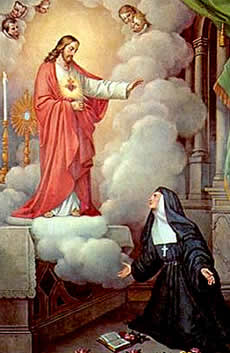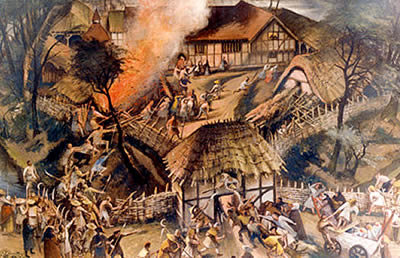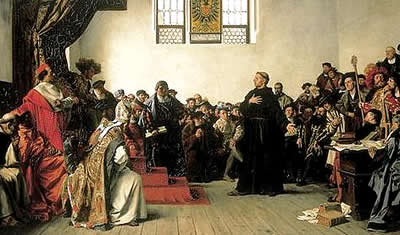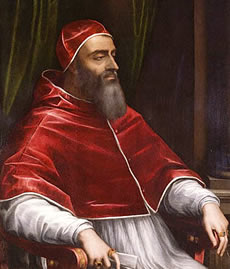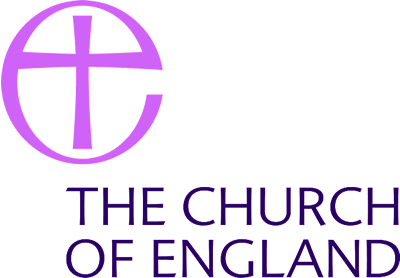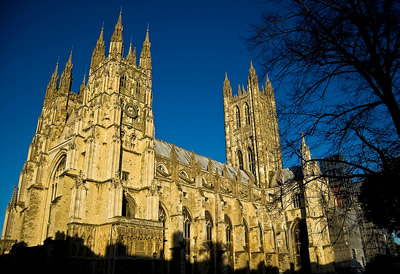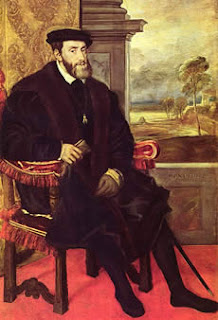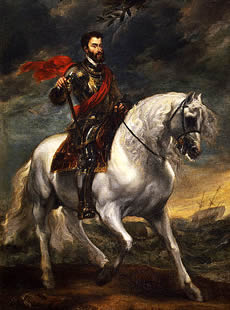 |
| Counter-Reformation in Europe |
Beginning in the late 15th century, calls for reform of the Catholic Church “in head and members”—that is, in respect to both the papal administration and the life of the faithful—had become commonplace in all ecclesiastical circles.
However, in the early 16th century, there were increasing calls from many sides for the calling of a General Council. The Fifth Lateran Council of 1512–17, called by Pope Julius II, undertook various reforms, but its pronouncements had little effect.
If reform “in the head” was stymied by political and bureaucratic inertia, reform “in the members” was proceeding ahead. The late 15th century saw reforms within the Franciscan, Augustinian, and Carmelite orders, leading, in the case of the Franciscans and Augustinians, to the founding of separate branches of the orders incorporating friars following a stricter version of their rule. It was indeed from the observant branch of the Augustinians that
Martin Luther came.
There was also a revival of the study of the theology of St. Thomas Aquinas, whose work had been neglected in most universities (outside his own Dominican order) in favor of the via moderna represented by
William of Ockham and Gabriel Biel. Cardinal Tomasso de Vio (1469–1534), known as Cajetan, a leading Dominican scholar and superior general of the order, led the way with new works on Thomistic theology.
At the same time, scholars using humanistic methods called for new approaches to education and theology, most notably Desiderius Erasmus (c. 1466–1536), Jacques Lefèvre d’Etaples (c. 1455–1536) in France, John Colet (1467–1519) and
Sir Thomas More (1478–1535) in England.
In Spain Cardinal Francisco Jiménez de Cisernos, an Observant Franciscan, carried out reforms of the church in Spain and opened the University of Alcalá in 1508, where many of the new methods of
learning were cultivated. It was there that the Complutensian Polyglot Bible, incorporating Hebrew, Greek, and Latin texts, was completed in 1517 and published three years later.
During the 15th century, a movement of spiritual renewal known as the Modern Devotion (Devotio Moderna) had attracted followers among both clergy and laity, especially in Northern Europe. This movement stressed personal devotion and conversion, rather than theological speculation.
The Imitation of Christ by Thomas à Kempis (1418) was the most popular representative work of this period. By the end of the century, groups of reformers that focused on personal piety and charitable works had emerged in several cities in Italy.
The Oratory of Divine Love, founded in Genoa by a layman, Ettore Vernazza, in 1497, brought together both clergy and laity in pursuit of holiness and good works. Vernazza moved to Rome early in the 16th century and founded an Oratory there. Branches of the Oratory were founded in a number of Italian cities, where they were the seedbeds of many later reform initiatives.
The foundation of new religious orders was central to the reforming efforts of the period. Several of these orders were of a new type, “clerks regular”—that is, priests (and in some cases lay brothers) living according to a religious rule, but not bound to celebration of the Divine Office in community as were monastic or mendicant orders.
This mode of living suited their orientation to active life, including preaching, teaching, and the hearing of confessions. The first of these orders were the Theatines, founded by Gaetano Thiene (1480–1547) and Gian Pietro Carafa (1476–1559), then bishop of Chieti, both of whom had been members of the Oratory of Divine Love. Their order was approved by Pope Clement VII in 1524.
Other such orders included the Clerks Regular of St. Paul, also known as the Barnabites, founded in Milan by Anthony Maria Zaccaria in 1533, and the
Society of Jesus (Jesuits), the best-known Counter-Reformation order. The Capuchins, officially approved in 1528 and active in spreading Catholic reform, were one of several offshoots of the Observant Franciscans, whose apostolate was nevertheless similar to that of the new orders.
The period also saw the foundation of the first orders of women oriented to the active life, including teaching and care of the sick. The best known of these were the Ursulines, founded in Brescia in 1535 by Angela Merici, a Franciscan associate who had also been a member of the Oratory of Divine Love.
For the first 20 years after Luther’s emergence onto the general European scene in 1517, it was by no means clear that his movement would provoke a split in the church. The doctrine of justification, which formed the basis of Luther’s teaching, had been much debated in the 15th century, especially within the schools of the via moderna from which Luther himself had emerged.
While his interpretation of this doctrine led Luther to reject the sacramental and hierarchical system of the Catholic Church, there were many who desired to preserve that system but at the same time adopt at least some of his theology. Likewise many of the attacks by Luther and his followers against corruption in the church echoed the concerns of both humanist and Observantine reformers.
Thus the writings of important bishops and thinkers were suspected of heresy in their teachings on grace and justification. The suspicions of the more traditional among the hierarchy were further confirmed when Bernardino Ochino, vicar-general of the Capuchins, and the popular preacher Pietro Martire Vermigli fled to Switzerland in 1542 and openly espoused Protestant doctrines.
Gaining Momentum for Reform The aktivitas of institutional reform gained momentum in the 1530s. Paul III, pope from 1534 to 1549, made a number of the leading reformers cardinals, increasing their influence within the church. In 1536, he commissioned a group of these same men to study the problems confronting the church. Their report, the Consilium de emendanda ecclesiae, presented in 1537, advised reform of the papal curia, better discipline for bishops, and reform of the religious orders.
This was the aktivitas for a coming General Council, for which not only church reformers, but likewise many secular rulers, in particular the
Holy Roman Emperor Charles V, had been calling for some time. Convocation of a council, however, was impeded by the continuing war between the emperor and the king of France.
The council was finally convened at Trent in 1545. Protestants were invited to send observers, but none attended. The
French likewise stayed away from the early sessions of the council, both because of its location in Imperial territory and because of suspicion that it would take measures that would interfere with the French king’s attempts to control the church in France.
The council’s doctrinal decrees reaffirmed traditional teaching in areas challenged by Protestants, such as the doctrine of free will and the sacraments. The disciplinary decrees of the council strengthened the authority of bishops over the clergy in their dioceses, at the same time demanding that bishops and other holders of pastoral responsibilities personally reside in their jurisdictions.
The council mandated the foundation of seminaries in every diocese for the training of priests, an innovation that was perhaps the most influential in the formation of the early modern Catholic Church.
The council also recognized the importance of the new medium of print by establishing the Index of Forbidden Books and providing that all works dealing with religious questions be approved beforehand by the local bishop.
The publication of the first index was the work of Pope Paul IV, whose reign was marked by an intensification of the efforts to stamp out heresy in Italy. While he himself was a reformer, he had suspected many Counter-Reformation figures of excessive sympathy with Protestantism, some of whom had to appear before Inquisition tribunals.
Council of Trent  |
| Council of Trent |
The institutional reforms mandated by the
Council of Trent were put into action only gradually. Pius IV set up a Congregation for the Council in 1563 to supervise its implementation; this was the first of the Roman congregations that became the central administration of the Catholic Church.
His successor, Pius V (reigned 1566–72), issued the Roman Catechism, a summary of Catholic teaching, and a revision of the Roman Missal that imposed a uniform standard for the liturgy of the Roman Rite.
Beyond Rome, the application of the Council of Trent, which proceeded gradually, nation by nation and diocese by diocese, depended on both the local bishops and the cooperation of secular rulers.
The council was applied relatively quickly in Spain and in parts of Italy. Cardinal Charles Borromeo (1538–84), archbishop of Milan and nephew of Pope Pius IV, set the pattern for many of these reforms. He established a seminary and enacted other provisions of the council in the administration of the diocese.
He brought the Ursulines and other new orders to Milan, and encouraged the work of the Confraternity of Christian Doctrine, which had been founded in 1536 for the purpose of the religious education of children and included both clergy and laypersons. His efforts extended beyond his diocese throughout northern Italy and Switzerland.
By the end of the Council of Trent, the Jesuit order had gained numerous vocations and considerable influence. Several Jesuit theologians participated in the council. The Jesuits had begun the first overseas missionary work in America, Africa, and particularly East Asia; Saint Francis Xavier (1509–52), one of Ignatius Loyola’s original companions, traveled to Goa in 1542 and spent the rest of his life evangelizing in India, the East Indies, and Japan, dying as he was preparing to enter China.
The Jesuits were also active within Europe, establishing schools and preaching to the public. In their schools, they combined humanist and Scholastic methods, aiming at attracting the ablest boys and those from the most influential social groups.
In many areas where substantial portions of the population had been converted to Protestantism, such as Austria and Bohemia, Jesuit education was one of the means by which these areas were returned to Catholicism by the first part of the 17th century. Jesuit preachers like Peter Canisius (1521–97) began a revival of what had become, by the middle of the 16th century, an almost moribund Catholic Church in Germany.
In Spain, a country where Protestantism had attracted very few followers, the Counter-Reformation was marked by a revival of religious and mystical life. The most prominent figure in this revival was the Carmelite reformer and spiritual writer Teresa of Jesus (or Teresa of Ávila, 1515–82) and John of the Cross (1542–91).
The revival of religious life characterizing the Counter-Reformation went beyond, however, religious orders and the clergy. The application of the Council of Trent affected the religious experience of laypeople in all parts of Catholic Europe.
Circles of “the devout” or “friends of God” had grown up in many places even before the advent of institutional reform. Reforming orders like the Jesuits built on these groups to form organized lay confraternities and sodalities to pursue prayer, education, and charitable works.
Confraternities devoted to the Virgin Mary and especially to the Blessed Sacrament held public processions and reaffirmed Catholic doctrines under attack by Protestants. At the same time, reforming bishops and pastors attempted to suppress quasi-magical devotional practices unapproved by church authority, which in many cases had attracted the criticism of Protestant reformers.
The Counter-Reformation left the Catholic Church more organized and disciplined. In many ways, the changes in the Catholic Church paralleled those introduced by Protestants in the areas under their control. Both created a disciplined and educated clergy and clearer teaching on doctrinal matters and attempted to bring about effective conversion of the mass of the population. Both relied to a greater degree on the cooperation of secular governments.
While many scholars have recognized the contribution of the Counter-Reformation to the strengthening of the Catholic Church, others have suggested that by raising the standards of education of the clergy and attempting to impose a uniform discipline on the laity, the Counter-Reformation alienated many of the uneducated masses and prepared the way for the secularization that began in the 18th century.

